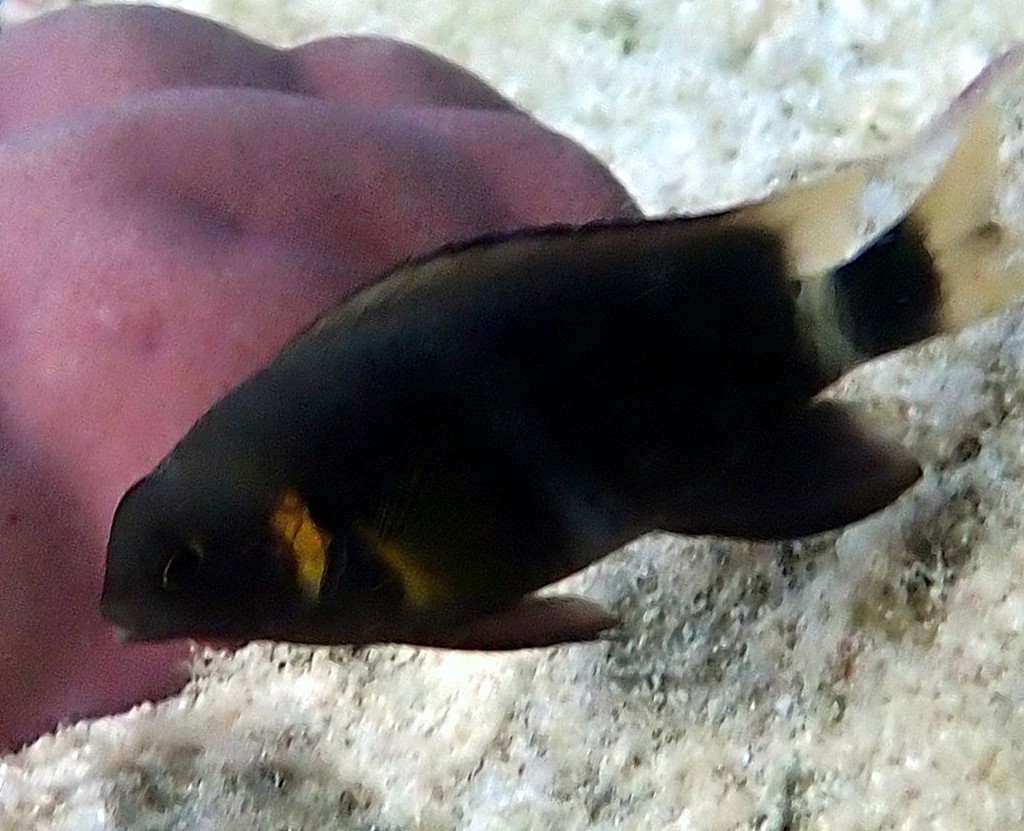CHRYSIPTERA LEUCOPOMA - (CUVIER, 1830)
Picture courtesy of: Claire Goiran
Actinopterygii (Gigaclass) > Actinopteri (Class) > Teleostei (Subclass) > Blenniiformes (Order) > Pomacentridae (Family) > Pomacentrinae (Subfamily) > Chrysiptera (Genus)
Actinopterygii (Gigaclass) > Actinopteri (Class) > Teleostei (Subclass) > Blenniiformes (Order) > Pomacentridae (Family) > Pomacentrinae (Subfamily) > Chrysiptera (Genus)
Surge damsel, Pacific surge damselfish, Surge demoiselle, White-banded damsel-fish, White-banded damselfish, Blueribbon damsel, Bloulint-nooientjie, Miyakokisen suzumedai, ミヤコキセンスズメダイ,
Synonymes
Abudefduf miyakoe (Okada & Ikeda, 1937)
Chrysiptera caudofasciata (Okada & Ikeda, 1939)
Glyphidodon taenioruptus (Cartier, 1874)
Glyphisodon leucopomus (Cuvier, 1830)
----------------------------
Description
Dorsal spines (total): 13; Dorsal soft rays (total): 12-13; Anal spines: 2; Anal soft rays: 11-13; Pectoral fin rays: 17-19; Lateral line scales: 17-19; Gill rakers: 17-21; Body depth: 2.3-2.7 in SL. Max. length: 8.0 cm TL. Depth range: 0 - 12 m.
Color
Yellow variant: body scattered with small blue dots arranged in lines. An electric blue stripe extends from the back of the muzzle to the caudal peduncle.
Brown variant: dark body with two vertical white bars, one in the middle and the other on the caudal peduncle. The operculum and fins are orange.
In both cases, there is a dark ocelli at the posterior base of the dorsal fin.
Etymology
Chrysiptera: from Greek, chrysos = golden + from Greek, pteron = fin, wing. Referring to yellow caudal fin and/or yellowish pectoral and ventral fins of Glyphisodon azureus Cuvier, 1830 (= Chrysiptera cyanea (Quoy & Gaimard, 1825))
biocellata: from Latin, bi = two + from Latin, ocellus or oculus = eyes, spot. Referring to large ocellus at dorsal-fin base on sides of juveniles (absent in adults).
Original description: Glyphisodon leucopomus Cuvier, 1830 - Type locality: Kosrae, Caroline Islands, western Pacific.
Distribution
Eastern Indian Ocean, western Pacific: Christmas Island and Indonesia, east to Wake Islands and Marquesas Islands, north to southern Japan, south to Western Australia, New South Wales (Australia), New Caledonia and Austral Islands.
Biology
Adults occur in rubble-strewn surge channels, the outermost reaches of exposed reef flats, and the upper submarine terrace. Territorial but they generally occur in groups, and remains close to shelter. Feed mainly on benthic algae and small crustaceans. Oviparous, distinct pairing during breeding. Eggs are demersal and adhere to the substrate. Males guard and aerate the eggs. Diurnal species.
Similar species
Chrysiptera brownriggii (Bennett, 1828) - Reported from Indian Ocean: South Africa, East Africa, Socotra (Yemen), Seychelles, Comoros, Madagascar and Mascarenes (La Réunion, Mauritius, Rodrigues), east to western Indonesia.
Last update: 8, June 2024
Synonymes
Abudefduf miyakoe (Okada & Ikeda, 1937)
Chrysiptera caudofasciata (Okada & Ikeda, 1939)
Glyphidodon taenioruptus (Cartier, 1874)
Glyphisodon leucopomus (Cuvier, 1830)
----------------------------
Description
Dorsal spines (total): 13; Dorsal soft rays (total): 12-13; Anal spines: 2; Anal soft rays: 11-13; Pectoral fin rays: 17-19; Lateral line scales: 17-19; Gill rakers: 17-21; Body depth: 2.3-2.7 in SL. Max. length: 8.0 cm TL. Depth range: 0 - 12 m.
Color
Yellow variant: body scattered with small blue dots arranged in lines. An electric blue stripe extends from the back of the muzzle to the caudal peduncle.
Brown variant: dark body with two vertical white bars, one in the middle and the other on the caudal peduncle. The operculum and fins are orange.
In both cases, there is a dark ocelli at the posterior base of the dorsal fin.
Etymology
Chrysiptera: from Greek, chrysos = golden + from Greek, pteron = fin, wing. Referring to yellow caudal fin and/or yellowish pectoral and ventral fins of Glyphisodon azureus Cuvier, 1830 (= Chrysiptera cyanea (Quoy & Gaimard, 1825))
biocellata: from Latin, bi = two + from Latin, ocellus or oculus = eyes, spot. Referring to large ocellus at dorsal-fin base on sides of juveniles (absent in adults).
Original description: Glyphisodon leucopomus Cuvier, 1830 - Type locality: Kosrae, Caroline Islands, western Pacific.
Distribution
Eastern Indian Ocean, western Pacific: Christmas Island and Indonesia, east to Wake Islands and Marquesas Islands, north to southern Japan, south to Western Australia, New South Wales (Australia), New Caledonia and Austral Islands.
Biology
Adults occur in rubble-strewn surge channels, the outermost reaches of exposed reef flats, and the upper submarine terrace. Territorial but they generally occur in groups, and remains close to shelter. Feed mainly on benthic algae and small crustaceans. Oviparous, distinct pairing during breeding. Eggs are demersal and adhere to the substrate. Males guard and aerate the eggs. Diurnal species.
Similar species
Chrysiptera brownriggii (Bennett, 1828) - Reported from Indian Ocean: South Africa, East Africa, Socotra (Yemen), Seychelles, Comoros, Madagascar and Mascarenes (La Réunion, Mauritius, Rodrigues), east to western Indonesia.
Last update: 8, June 2024
